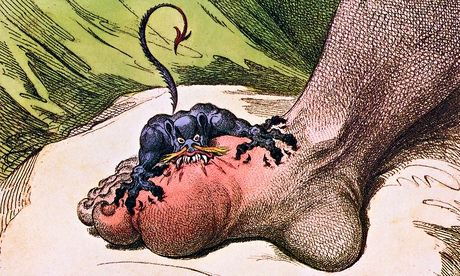
My first encounter with gout was in the pages of Little Lord Fauntleroy, the tale of an American boy from a humble background who turns out to be the heir of a crusty English earl. But gout is no longer a privilege of the port-swigging aristocracy, if it ever was. New research suggests 1.6 million people in the UK have it and the numbers are rising fast, at a rate of about 4% a year.
It is excruciatingly painful and for the most part avoidable. Some people have a genetic predisposition and it is more common in men, but it is mostly your lifestyle that makes the difference. It is increasing with obesity and heavier drinking.
Gout, the most common form of inflammatory arthritis, is caused by a build-up of uric acid, which is produced when the body breaks down chemicals in foods called purines. The kidneys should get rid of it, but if they are not working well, or there is too much uric acid for them to cope with, the excess can turn into crystals that lodge particularly in toe and finger joints, causing swelling and serious pain.
So to avoid it, watch your weight and be wary of food and drinks that are high in purines. Beer is a particular problem (a Nottingham University study found the highest rates in the north-east of England). Spirits and red wine are bad; white wine is slightly less so.
Just to make things difficult, some of the foods we are told are healthy are a problem for those with gout. Oily fish, such as herring and mackerel, are otherwise extremely good for us, but increase the risk. Shellfish is a problem. Yeast extracts are bad. So is offal, such as liver, sweetbreads and tripe. Soft drinks containing fructose, which have been implicated in obesity, are also thought by some scientists to be better avoided.
Arthritis Research UK, which offers help and advice, says the best strategy is to keep your weight down, be active and drink lots of water.

